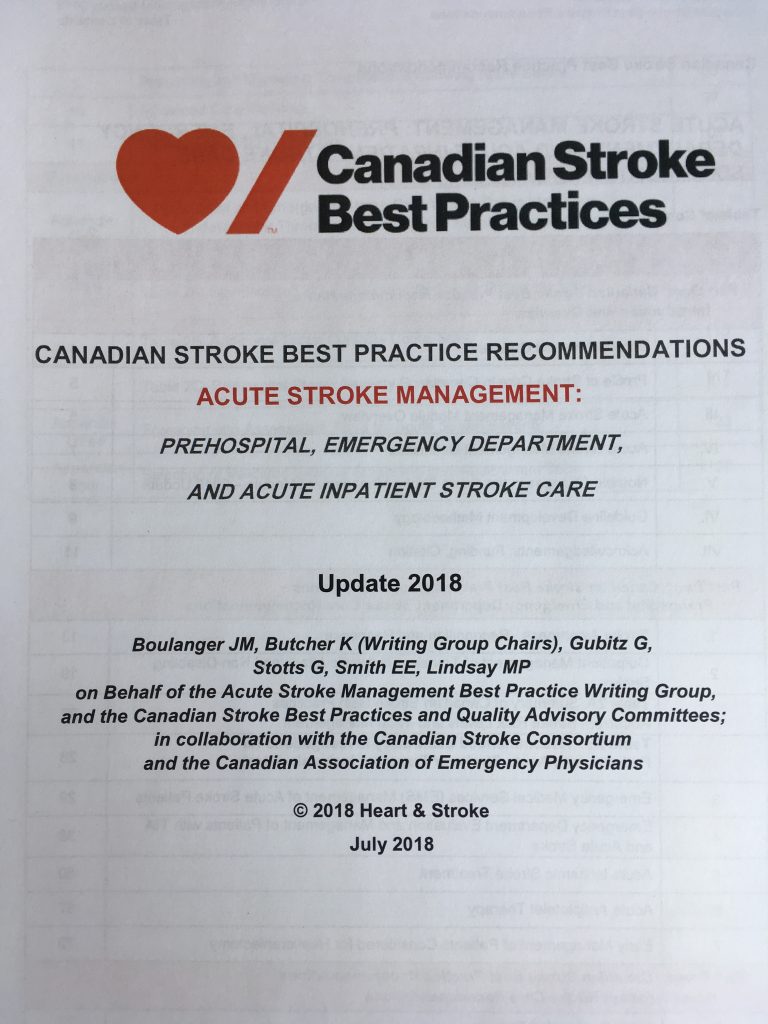| On behalf of Patrice Lindsay RN, PhD, Director of Stroke, Heart & Stroke, we are pleased to share the following announcement:
New releases from the Canadian Stroke Best Practice Recommendations for acute stroke management and acute stroke management during pregnancy
An important update and a new consensus statement have been released for the Heart & Stroke Canadian Stroke Best Practice Recommendations (CSBPR). Acute Stroke Management: Prehospital, Emergency Department, and Acute Inpatient Stroke Care as well as a new consensus statement on Acute Stroke Management during Pregnancy are now available.
The CSBPR for Acute Stroke Management address the first hours and days after stroke occurs, starting with the onset of stroke signs and symptoms through to discharge from the emergency department or acute inpatient care. This module combines what was formerly two separate modules on hyperacute stroke care and acute inpatient stroke care, and contains several significant changes based on recent emerging research evidence. The acute stroke management writing group chairs are Jean-Martin Boulanger and Kenneth Butcher.
Important changes and updates to these recommendations:
- A two-step screening is now recommended by paramedics on scene to determine both likelihood of stroke and stroke severity;
- An expanded role for advanced imaging for patient selection for patients arriving outside the 6 hour time window;
- Based on recently published DAWN and DEFUSE3 clinical trials, the window for a highly selected group of patients with large ischemic strokes to receive endovascular thrombectomy has been increased to up to 24 hours after last known to be well;
- New clinical considerations have been added for acute intravenous thrombolysis treatments for a highly selected group of people with stroke of unknown time of onset with lapse time (the time between when someone was last seen normal to the when they were seen experiencing symptoms or they woke up) beyond the 4.5 hour time window.
- New recommendations have been developed for use of dual antiplatelet therapy during the initial post-stroke period, based on recently released POINT clinical trial results.
A new consensus statement on acute stroke management during pregnancy is the second of a two-part series on stroke in pregnancy (part one focused on prevention of recurrent stroke in pregnancy). It addresses stroke during pregnancy or in the postpartum period (generally including the first 12 weeks post-delivery), which is a devastating event for new parents and their families. Noor Ladhani and Richard Swartz chair the stroke in pregnancy writing group.
Key considerations when a stroke occurs in pregnancy are included consensus statement:
- A standardized approach to coordinated care is essential for investigation, diagnosis, and intervention planning.
- Factors to consider include the timing of stroke within the pregnancy, stroke severity, expected maternal outcomes, and the known or theoretical impact of decisions and interventions on the fetus.
- Whenever possible, the same decisions for acute treatment and management should be considered for a woman who is pregnant. Maternal health should be the priority and delays or deferral of critical steps in diagnosis and life-saving care due to pregnancy should be minimized.
Revised CSBPR for Acute Stroke Management and the consensus statement on Acute Stroke Management during Pregnancy have been published in the International Journal of Stroke and are part of the sixth edition of the Heart & Stroke Canadian Stroke Best Practice Recommendations.
Click here to access the methodology on the CSPBR website.
New Resources to support Implementation of the CSPR:
- As part of this update to Acute Stroke Management, a new training video has been produced using the Canadian Neurological Scale. The link has been added to our webinar series pages in the Resources section of the SBP website.
- All supporting materials for both the acute stroke module and the acute stroke in pregnancy consensus statement including implementation resources and performance measures are available at www.strokebestpractices.ca.
|

